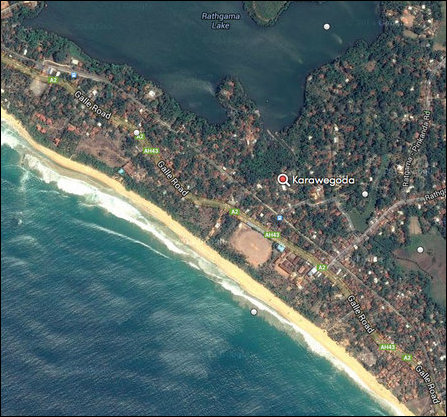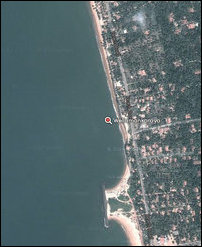Know the Etymology: 353
Place Name of the Day: Wednesday, 04 June 2014
Karaiyoor, Karaawe-goda
கரையூர்,
கராவெகொ3ட3
Karaiyūr, KarāvegoḍaKarai+oor
Karaawe+goda
The seaside village
The seaside bank or village
| Karai |
Shore, bank, ridge of a field (Tamil, DED 1293); Kara: shore, riverside, land opposed to sea (Malayalam, DED 1293); Shore, bank (Telugu, DED 1293); Kare: Bank, shore, boundary (Kannada, DED 1293); Bank (Kodagu DED 1293); Seashore, bank of a river, border (Tulu, DED 1293); Garre: Near (Gonda, DED 1293); Karrak: Bank, shore, brim, border, edging, near (Brahui of Pakistan, DED 1293); Karaiyaar: A coastal community (Tamil)
|
| Karaa |
(adjective) Near, proximate (Sinhala, Clough); Sea, seashore, Muhuda, Muhudu-werala (Sinhala, Sorata); Kara: Sea (Sinhala, Sorata); Karaa-kapudu, Karaa-kaak; Seaside crow (Sinhala, Sorata); Karaawa: A coastal community (Sinhala);
|
| Oor |
Village, town, city (Tamil, Malayalam DED 752); Village (Kota, DED 752); Village of Tamils or Badagas (Toda, DED 752); Village, Town (Kannada, DED 752); Village (Naikri, DED 752); Uri: Village (Kodagu, DED 752); Ooru: Village, town (Tulu, Telugu DED 752); Uraa: House (Brahui, DED 752);
|
| Goda |
Heap, mass, land at the edge of water, village, hamlet, hill in place names (Sinhala); Godælla: Hill, mound, rising ground (Sinhala); Koadu: Summit of a hill, peak, mountain (Tamil, DED 2049); Bank of stream or pool (Tamil, DED 2200); Place name suffix for mountains and hills (Tamil, Malayalam); Gudde: Heap, pile (Kannada, DED 1682); Hill (Tulu, DED 1642); Heap (Kodagu, DED 1642); Field on mountain slopes (Telugu, DED 1682); Gude: Hill (Konda, DED 1642). See columns on Naarang-goda-paa'luwa, Veyangoda, Para-goda and Ælla-goda
|

The location of Karaawe-goda. [Image courtesy: Google Earth]
Karai in Tamil, listed as a word of Dravidian etymology (DED 1293), and Karaa in Sinhala, generally mean a shore.
Related to the meaning, edge or side for the Karai-related words in Dravidian, Karaa in Sinhala also mean near or proximate (see the Gonda and Brahui parallels in the box)
The identity of a coastal community, Karaiyaar in Tamil and Karaawa in Sinhala come from the word Karai/ Karaa, meaning seashore.
The word Karaa takes the ‘wa’ affix in Sinhala.
* * *Oor is a popular Dravidian word (DED 752), generally meaning an established village. In old Tamil the word also meant a town or city, in addition to an established and protected village.
In some instances, the component is also found in the Sinhala place names, as in the example of Nallooruwa in Panadura division.
See earlier columns for discussions on the Dravidian etymology of Goda, meaning bank, heap, mound, hill, or village in Sinhala. The village meaning comes as a high-ground near a waterfront or low-ground paddy field, is usually chosen for a settlement
* * *Karaawe-goda is in Hikkaduwa division of Galle district
Karaiyoor is in
Jaffna city of Jaffna district
* * *Some related place names:Karaa as a coastal place:Mahaa-karaawa: The grand coastal place; Balapitiya division, Galle district
Karaawa: The seaside; Kadaweediya South of Matara Town, Matara district
Karaa-goda: The coastal mound or village; Yakkalamulla division, Galle district

The location of Wellaman-karaya. [Image courtesy: Google Earth]
The sandy seashore; or the seashore of white sands; Wennappuwa division, Puththa’lam district
Kara as a side or a nearby place:Karaa-pitiya: The adjacent high ground (of a paddy field stretch); Bope-Poddala division, Galle district. The place, which is a high ground, borders a paddy field stretch
Kara-mætiya: The lakeside clay land; or the clayey land of Kara shrubs; or the barren earth; Katuwana division, Hambantota district. Kara-mætiya is located at the side of a reservoir. Mæti: clay, earth (Sinhala); Kara-bima: unfruitful land (Sinhala); Karisal, Karu-nilam; Karampai-nilam: waste land, barren soil (Tamil, DED 1285)
Gini-karaawa: The side found with the plant Plumbago rosea; Kunegala division, Kurunegala district. Gini: fire, heat, the plant Plumbago rosea (Sinhala)
Kara-vita: The lakeside mound; or the mound of Kara shrub; Chilaw division, Puththa’lam district. Karavita is located at the bank of a lake. Kara: side as well as Kara shrub; Vita: hill, mound (Sinhala)
Kara-vitaa-gara: The house at the lakeside mound; Chilaw division, Puththa’lam district. Gara: house (Sinhala)
Kara-goda: The bank or village at the side; Kamburupitiya division,Matara district
* * *Karai: Kadat-karaich-cheanai: The shifting cultivation field at the seashore; Moothoor division, Trincomalee district
Theerththak-karai: The waterfront to perform a temple ritual; Poaratheevup-pattu division, Batticaloa district; Karaithu’raippattu division, Mullaiththeevu district
Aattang-karai-veddai: The open land at the bank of the river; Ea’raavoor Town division, Batticaloa district
Ak-karaip-pattu: The division on the other bank; Alaiyadivempu division, Ampaarai district
Ooththang-karai: The side (waterfront) of the spring or waterhole; Karaithuraippattu division, Mullaiththeevu district
Paddik-karai: The side or waterfront for the cattle; Karaithu’raippattu division, Mullaiththeevu district
A’lampil-karat-karai: The seashore of A’lampil; Karaithu’raippattu division, Mullaiththeevu district
Ak-karai-ve’li: The open land on the opposite side; Karaithu’raippattu division, Mullaiththeevu district
Mu’rippaan-karai: The bank, side or waterfront of the barrage; Oddusuddaan division, Mullaiththeevu district
Kurakkan-karai: The side for cultivating finger millet; Oddusuddaan division, Mullaiththeevu district
Karaiya-othiya-malai: The waterfront part of Othiyamalai; Oddusuddan division, Mullaiththeevu district
Thellik-karai: The bank or side of the paddy fields of long plots; Poonakari division, Ki’linochchi district
Maduk-karai: The bank or side of the tank; Ka’ndaava’lai division, Ki’linochchi district
Karai-a’naikkadduk-kiraamam: The side or waterfront part of the village of dam; Ka’ndaava’lai division, Ki’linochchi district
Kudaththanai-karayoor; The coastal settlement part of the Kudaththanai village; Vadamaraadchi East division, Jaffna district
Oadaik-karai; The waterfront or side of the pond or water course; Oadak-karai: The seafront for boats; Vadamaradchi North division, Jaffna district
Karaip-piddi: The adjacent high ground (of a paddy field stretch); Kaarainakar division, Jaffna district;
Karai-piraa’n: The deity (Pi’l’lyaar) on the side of a pond, or on the side of the paddy field stretch; Aanaikkoaddai, Jaffna district
* * *Oor:Nall-oor: The good village/ town, or the abundant village/ town; Nalloor division, Jaffna district; Poonakari division, Ki’linochchi district: Moothoor division, Trincomalee district. Nal: good, abundant, copious, excellent (Tamil, DED 3610)
Nall-ooruwa: The good village/ town or the abundant village/ town; Panadura division, Kalutara district
Maappaa’na-oori: The village of a chief, Maap-paa’nam; Kaarainakar division, Jaffna district. Oori is a form of Oor (Tamil)
Paasaiy-oor: The village paying fishing tax; or the village taken the fishing contract; Jaffna division, Jaffna district
Uzhavan-oor: The village of cultivators; Ka’ndaava’lai division, Ki’linochchi district; Oddusuddaan division, Mullaiththeevu district
Ezhthth-oor: The village that was endowed; Mannaar Town division, Mannaar district
Marakkaay-oor: The village of a navigator (Marakkaayar: usually a Muslim navigator); Musali division, Mannaar district
Kurukka’l-oor: The village of a Saiva Brahmin; Oddusuddaan division, Mullaiththeevu district
Murukan-oor: The village of God Murukan; Oddusuddaan division, Mullaiththeevu district
Ka’lapp-oor: The village of the backwaters; Kaaraitheevu division, Ampaa’rai district
Kadal-oor: The seaside village; Koa’ra’laippattu division, Batticaloa district; Kuchchave’li division, Trincomalee district
Paalaiy-oor: The village of a Paalai tree; Ea’raavoor pattu division, Batticaloa district
Veal-oor: The village of the Veal (God Murukan worshipped in the form of Veal), Kuchchave’li division, Trincomalee district
Kalladi-veal-oor: The village of the Veal (God Murukan worshipped in the form of Veal), which is part of the Kalladi village; Ma’nmunai North division, Batticaloa district
Thiruchchenthoor: The village named after Thiruchchenthoor in Tamil Nadu; Ma’nmunai North division, Batticaloa district
Makizh-oor: The village of Makizha trees; Ma’nmunai South division, Batticaloa district
Senthoor: The village named after Thiruchchenthoor in Tamil Nadu; Kuchchave’li division, Trincomalee district
Thagnchaavoor: The village named after Thagnchaavoor in Tamil Nadu; Kuchchave’li division, Trincomalee district
Cheanaiy-oor: The village of the shifting cultivation field; Moothoor division, Trincomalee district
Champ-oor: The village of Champu grass; Moothoor division, Trincomalee district
Thiruk-kadal-oor: The sacred seaside village; Trincomalee Town and Gravets division, Trincomalee district
First published: Wednesday, 04 June 2014, 18:45
Previous columns:








